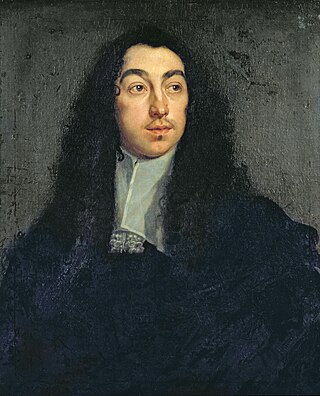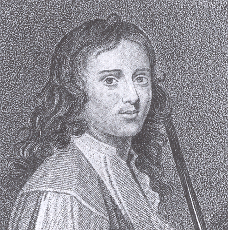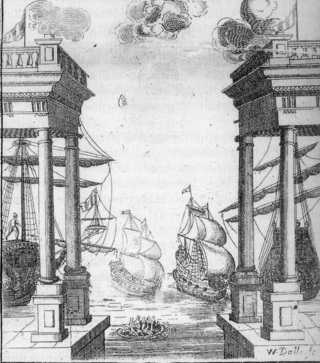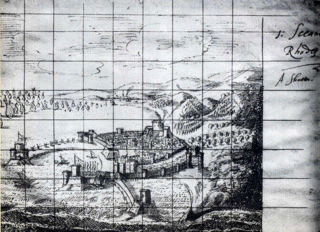Related Research Articles

Sir William Davenant, also spelled D'Avenant, was an English poet and playwright. Along with Thomas Killigrew, Davenant was one of the rare figures in English Renaissance theatre whose career spanned both the Caroline and Restoration eras and who was active both before and after the English Civil War and during the Interregnum.
This article contains information about the literary events and publications of 1674.
The history of opera in the English language commences in the 17th century.

Thomas Killigrew was an English dramatist and theatre manager. He was a witty, dissolute figure at the court of King Charles II of England.

Matthew Locke was an English Baroque composer and music theorist.

Michael Mohun was a leading English actor both before and after the 1642–60 closing of the theatres.

The Restoration spectacular was a type of theatre production of the late 17th-century Restoration period, defined by the amount of money, time, sets, and performers it required to be produced. Productions attracted audiences with elaborate action, acrobatics, dance, costume, scenery, illusionistic painting, trapdoors, and fireworks. Although they were popular with contemporary audiences, spectaculars have earned a reputation from theatre historians as vulgar in contrast to the witty Restoration drama.

The Siege of Rhodes is an opera written to a text by the impresario William Davenant. The score is by five composers, the vocal music by Henry Lawes, Matthew Locke, and Captain Henry Cooke, and the instrumental music by Charles Coleman and George Hudson. It is considered to be the first English opera.

Heroic drama is a type of play popular during the Restoration era in England, distinguished by both its verse structure and its subject matter. The subgenre of heroic drama evolved through several works of the middle to later 1660s; John Dryden's The Indian Emperour (1665) and Roger Boyle's The Black Prince (1667) were key developments.

King Arthur, or The British Worthy, is a semi-opera in five acts with music by Henry Purcell and a libretto by John Dryden. It was first performed at the Queen's Theatre, Dorset Garden, London, in late May or early June 1691.
The terms "semi-opera", "dramatic[k] opera" and "English opera" were all applied to Restoration entertainments that combined spoken plays with masque-like episodes employing singing and dancing characters. They usually included machines in the manner of the restoration spectacular. The first examples were the Shakespeare adaptations produced by Thomas Betterton with music by Matthew Locke. After Locke's death, a second flowering produced the semi-operas of Henry Purcell, notably King Arthur and The Fairy-Queen. Semi-opera received a deathblow when the Lord Chamberlain separately licensed plays without music and the new Italian opera.

The Cockpit was a theatre in London, operating from 1616 to around 1665. It was the first theatre to be located near Drury Lane. After damage in 1617, it was named The Phoenix.
The year 1658 in music involved some significant events.
Henry Herringman (1628–1704) was a prominent London bookseller and publisher in the second half of the 17th century. He is especially noted for his publications in English Renaissance drama and English Restoration drama; he was the first publisher of the works of John Dryden. He conducted his business under the sign of the Blue Anchor in the lower walk of the New Exchange.

The Duke's Company was a theatre company chartered by King Charles II at the start of the Restoration era, 1660. Sir William Davenant was manager of the company under the patronage of Prince James, Duke of York. During that period, theatres began to flourish again after they had been closed from the restrictions throughout the English Civil War and the Interregnum. The Duke's Company existed from 1660 to 1682, when it merged with the King's Company to form the United Company.
Claricilla is a Caroline era stage play, a tragicomedy written by Thomas Killigrew. The drama was acted c. 1636 by Queen Henrietta's Men at the Cockpit Theatre, and first published in 1641. The play was an early success that helped to confirm Killigrew's choice of artistic career.
The Indian Emperour, or the Conquest of Mexico by the Spaniards, being the Sequel of The Indian Queen is an English Restoration era stage play, a heroic drama written by John Dryden that was first performed in the Spring of 1665. The play has been considered a defining work in the subgenre of heroic drama, in which "rhymed heroic tragedy comes into full being." As its subtitle indicates, the play deals with the Spanish conquest of the Aztec Empire under Hernán Cortés.
The History of Sir Francis Drake was a hybrid theatrical entertainment, a masque or "operatic tableau" with an English libretto written by Sir William Davenant and music by Matthew Locke. The masque was most likely first performed in 1659 and produced by Davenant. As with his earlier The Siege of Rhodes (1656) and The Cruelty of the Spaniards in Peru (1658), Davenant cast The History of Sir Francis Drake as a musical drama to avoid the Puritan prohibition of stage plays during the English Commonwealth era. The three Davenant works were important in the evolution of English opera and musical theatre, and heralded the coming revival of drama with the Restoration of 1660.
The Playhouse to be Let is a Restoration stage play, a dramatic anthology of short pieces by Sir William Davenant that was acted in August 1663 at the theatre at Lincoln's Inn Fields, and first published in the 1673 collected edition of Davenant's works. The Playhouse to Be Let is noteworthy for providing the first English translation of a play by Molière.
Thomas Duffet, or Duffett, was an Irish playwright and songwriter active in England in the 1670s. He is remembered for his popular songs and his burlesques of the serious plays of John Dryden, Thomas Shadwell, Elkanah Settle and Sir William Davenant.
References
- ↑ Terence P. Logan and Denzell S. Smith, eds., The Later Jacobean and Caroline Dramatists: A Survey and Bibliography of Recent Studies in English Renaissance Drama, Lincoln, NE, University of Nebraska Press, 1978; p. 204.
- ↑ Janet Clare, Drama of the English Republic, 1649–1660: Plays and Entertainments, Manchester, Manchester University Press, 2002.
- ↑ Dale B. J. Randall, Winter Fruit: English Drama 1642–1660, Lexington, KY, University Press of Kentucky, 1995; p. 175.
- ↑ Ian Spink, Henry Lawes: Cavalier Songwriter, Oxford, Oxford University Press, 2000; p. 111.
- ↑ Susan Wiseman, Drama and Politics in the English Civil War, Cambridge, Cambridge University Press, 1998; p. 145.
- ↑ Dougald MacMillan, "The Sources of Dryden's The Indian Emperour," Huntington Library Quarterly, Vol. 13 No. 4 (August 1950), pp. 355–70.